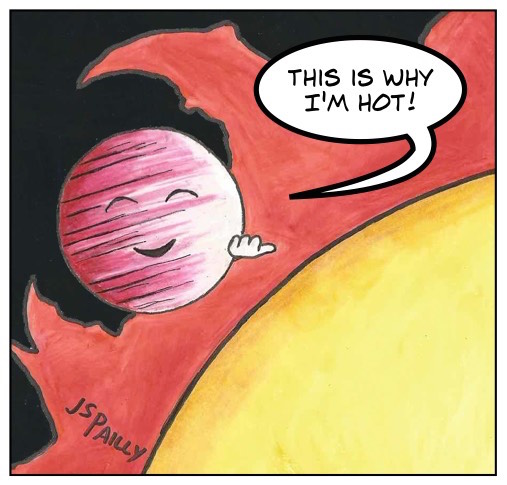Sciency Words is a special series here on Planet Pailly celebrating the rich and colorful world of science and science-related terminology. Today, we’re looking at the term:
HOT JUPITER
Hot Jupiters are defined as large gas giants, roughly Jupiter-sized, in orbits less than 0.5 AU from their host stars (half the distance between Earth and the Sun). Many hot Jupiters orbit much closer than that.
Since the 1990’s, astronomers have catalogued hundreds of hot Jupiters. Current models of planet formation indicate that gas giants cannot form so close to stars, so hot Jupiters must begin life father away and migrate inwards.
These planetary migrations can have dramatic effects on the rest of a star system.
The Creator of Worlds
As star systems coalesce, gas giants like Jupiter are among the first objects to appear. In some cases, a young gas giant might migrate inward while the other planets are still forming. The denser the protoplanetary disk, the more likely it is that a gas giant will migrate.
In computer simulations, researchers found that an inward migrating giant is actually good for a developing star system. Its passage stirs things up, encouraging planet formation.
Terrestrial planets that form in this way would benefit from the mixing of material from different regions of the protoplanetary disk. In the simulations, some ended up with way more water than Earth could ever dream of!
The Destroyer of Worlds
Of course if a giant planet migrates inward after the inner planets form, all bets are off. These smaller planets would either be gobbled up by the giant or hurled out of orbit by the giant’s gravity.
This scenario could happen if a Jupiter-sized planet were nudged by gravitational interactions with other large planets or by interactions with nearby stars. Gas giants in binary star systems would be at especially high risk.
The Destabilizer of Stars
Hot Jupiters are often found in high inclination (tilted) or retrograde (backward) orbits when compared to the orbits of their host stars. For a long time, astronomers wondered what happened to the orbits of these planets. A better question might be what happened to the rotations of these stars?
The presence of such a large object so close to a star could have a destabilizing effect on the star. New research suggests that hot Jupiters cause their stars to tilt sideways or tip upside down. This would explain the highly inclined and retrograde orbits we’ve observed.
Is This Normal?
Astronomers have discovered a whole lot of hot Jupiters, but that doesn’t mean they’re common. It’s just that with our current detection techniques, hot Jupiters are among the easiest planets to spot.
Rare or not, hot Jupiters would be worth closer inspection by futuristic space explorers. What sorts of adventures might these explorers have? Please share in the comments below.
Links
Why Doesn’t Our Solar System Have a Hot Jupiter? from Space Answers.
Build Your Own Orbit (Hot Jupiters) from Artifexian.
“Hot Jupiter” Systems May Harbor Earth-like Planets from Physics.org.
Mystery of “Hot Jupiter” Planets’ Crazy Orbits May Be Solved from Space.com.


I am blown away by the idea that the hot Jupiters can cause stars to move. That is definitely cool.
LikeLike
That surprised me too. I would have expected the opposite, based on the way the Moon supposedly helps stabilize the Earth.
LikeLiked by 1 person
Didn’t know about hot Jupiters affecting their star’s rotation either. That is freaky.
Adventures around a hot Jupiter? Temperature would obviously be an issue. I doesn’t sound like they would have substantial moons. Maybe a more interesting question is what things might look like on a rocky planet in that solar system. Could you imagine what a Jupiter in close orbit around our sun might look like? Imagine what sort of mythologies primitive natives on the planet might come up with to explain that sight.
LikeLiked by 1 person
I’ve been thinking a lot about that too. At one time, astronomers suspected there might be another planet (which they named Vulcan) inside the orbit of Mercury. They thought that would explain the anomalous precession of Mercury’s perihelion.
Maybe some other civilization out there really has a Vulcan-like planet. If it’s close enough to their sun, they might not even be able to see it!
LikeLiked by 1 person
I would think that a hot Jupiter would be visible when seen from a rocky world in the habitable zone, and utterly freaky looking.
LikeLiked by 1 person
I think it depends on how close it is to the star. If it’s one of those hot Jupiters that’s so close it’s almost inside the star’s corona, it might be difficult to spot without a telescope.
The discovery of such a planet by an alien Galileo could be a great turning point for some alien civilization.
LikeLiked by 1 person